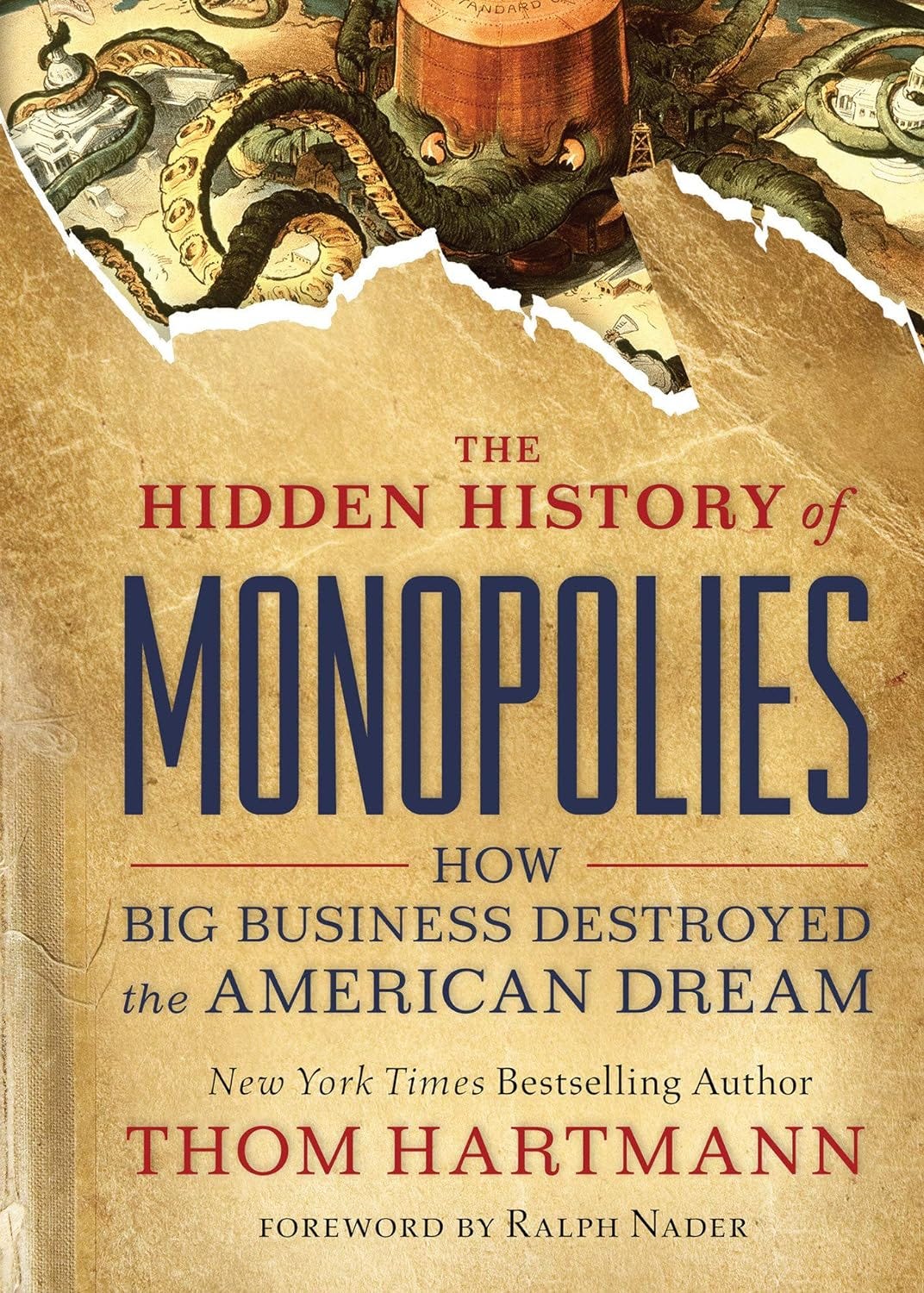How Reaganomics Killed the Jetsons
The Hidden History of Monopolies: How Big Business Destroyed the American Dream

Ms. Mornin: That’s good, because I work three jobs and I feel like I contribute.
President Bush: You work three jobs?
Ms. Mornin: Three jobs, yes.
President Bush: Uniquely American, isn’t it? I mean, that is fantastic that you’re doing that.
—President George W. Bush, Omaha, Nebraska, Town Hall, February 2005
President George W. Bush (and President Donald Trump, who bragged about low unemployment although virtually all newly created jobs during his presidency were low-paying) might have thought it was “fantastic” that one of his supporters had to work three jobs to pay her family’s bills, but most Americans wouldn’t agree, and never have.
The movement to restrict labor to 10 hours a day (from the then-widespread 14-hour day) got underway in the United States and Great Britain in the 1830s and reached its peak here after the Civil War, and in England in 1847 with the passage of the Factories Act.
The fight for the eight-hour day was kicked off in a big way by President Ulysses S. Grant in 1869, when he declared by proclamation that it should be the industrial standard of the United States. The United Mine Workers won it in 1898, and in 1926 Henry Ford adopted it, after years of agitation by his workers. The great Flint Sit-Down Strike of 1937 caused its adoption across the auto industry and most others.
In 1980, the year before Reagan kicked off his “revolution,” the 40-hour work week was standard all across America, although since then the hours that workers put in have steadily risen as the rate of unionization has fallen from around a third of all workers when Reagan was inaugurated to around 6% of the private workforce today.
But this was not the state of life for human beings during the vast majority of our history.
Back in the early 1960s, Richard Borshay Lee spent almost two years with the !Kung Bushmen in a part of what is now Botswana called Dobe. He wrote,
“In all, the adults of the Dobe camp worked about two and a half days a week. Since the average working day was about six hours long, the fact emerges that !Kung Bushmen of Dobe, despite their harsh environment, devote from twelve to nineteen hours a week to getting food. Even the hardest-working individual in the camp, a man named ≠oma who went out hunting on sixteen of the twenty-eight days, spent a maximum of thirty-two hours a week in the food quest.”
Marshall Sahlins, in his 1974 book Stone Age Economics, estimated, based on the fieldwork of Lee and others, that the average hunter-gatherer worked between three and five hours a day. Which Time magazine posited, in 1966, was where we’d be by the year 2000, a third of a century off in the future.
Just a few years earlier, Hanna-Barbera had produced a cartoon show called The Jetsons, about a family in the future, where George Jetson, the family patriarch, worked at Spaceley’s Sprockets, doing the difficult work of pushing a button every 10 minutes or so. The future was going to be, at least for working people, easier.
And, indeed, Time noted,:
“By 2000, the machines will be producing so much that everyone in the U.S. will, in effect, be independently wealthy. With Government benefits, even non-working families will have, by one estimate, an annual income of $30,000–$40,000. How to use leisure meaningfully will be a major problem.”
And that was $30,000 to $40,000 in 1966 dollars, which would be roughly $199,000 to $260,000 in today’s dollars.
Or, instead of taking a paycheck that was so much larger, American workers could take the same pay they already had and, like George Jetson, just push a button for three or four hours a day.
Ask anybody who was teenage or older in the 1960s: this was the big sales pitch for automation and the coming computer age. Americans looked forward to increased productivity from robots, computers, and automation translating into fewer hours worked or more pay, or both, for every American worker.
There was good logic behind the idea in 1966, because back then, that was how things actually worked.
The premise was simple. With better technology, companies would become more efficient and make more things in less time. Revenues would skyrocket, and Americans would bring home bigger and bigger paychecks, all the while working less and less. By the year 2000, Time posited, we would enter what was then referred to as “The Leisure Society.”
Futurists speculated that the biggest problem facing America in the future would be just how the heck everyone would use all their extra leisure time!
Then came 1980.
The industrialists and financiers who helped put Reagan in office and cheered him on with their think tanks and media also saw this increased productivity coming, and with it a huge opportunity. What if all that productivity—and the extra revenue it would create—could go to them instead of to the workers?
All it would take would be to break the unions, lower top tax rates so that the money didn’t end up with the government instead, and reconfigure corporate governance laws to let small- and medium-sized companies be gobbled up by giant corporations that could provide CEOs and senior executives with pay in the million-dollars-a-month to million-dollars-a-day range.
Reagan obligingly saw to it all, and right-wing think tanks and their monopolist funders have kept us there ever since.



